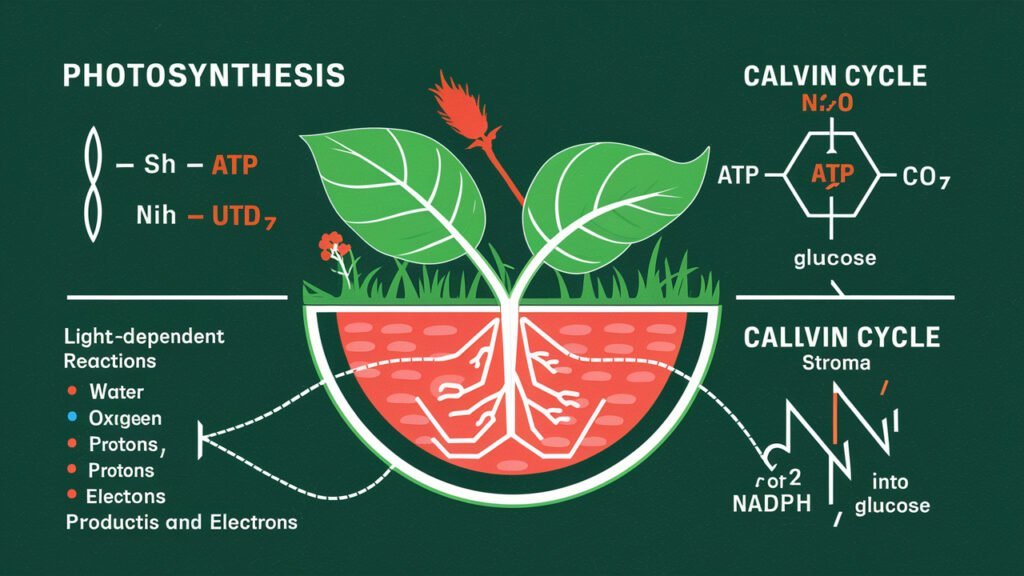
Photosynthesis in Higher Plants MCQ in NEET Biology
Photosynthesis is the process by which green plants make their food using sunlight, carbon dioxide and water. In higher plants, this process mainly occurs in the leaves, specifically within cells containing chloroplasts. Chloroplasts have a pigment called chlorophyll, which captures sunlight. Photosynthesis can be divided into two main stages: the light-dependent reactions and the light-independent reactions (Calvin cycle).
In the light-dependent reactions, which occur in the thylakoid membranes, sunlight energy is used to split water molecules, releasing oxygen and producing energy-rich molecules, ATP and NADPH. In the Calvin cycle, which takes place in the stroma of the chloroplast, ATP and NADPH are used to convert carbon dioxide into glucose, which plants use as an energy source.
Understanding photosynthesis is important for NEET students, as it is a fundamental concept in biology. The efficiency of this process affects the growth and productivity of plants, impacting ecosystems and agriculture. Higher plants have evolved various adaptations to optimize photosynthesis, such as leaf structures that maximize light absorption and mechanisms to minimize water loss.
| NEET 2025 Exam Important Links | |
|---|---|
| NEET 2025 Updated Syllabus | NEET Eligibility Criteria 2025 |
| Biology Preparation | Chemistry NEET Preparation |
| NEET Preparation tips for 2025 | NEET Result 2024 |
Photosynthesis in Higher Plants MCQ in NEET Biology
Photosynthesis in higher plants is a key topic in the NEET syllabus, essential for understanding how plants convert light energy into chemical energy. This process occurs mainly in the leaves, within specialized cell structures called chloroplasts. Chloroplasts contain the pigment chlorophyll, which captures sunlight. Photosynthesis is divided into two stages: the light-dependent reactions and the Calvin cycle.
For NEET students, mastering photosynthesis is important as it forms the basis of plant physiology and ecology. The efficiency of photosynthesis influences plant growth, agriculture, and ecosystem health. Understanding this process includes studying the roles of chlorophyll, the mechanisms of photophosphorylation and the biochemical steps of the Calvin cycle. Proficiency in photosynthesis helps students grasp broader biological concepts and prepares them for exam questions related to plant biology.
MCQ for NEET
\( \mathrm{CO}_{2}+\mathrm{H}_{2} \mathrm{O} \longrightarrow \mathrm{C}_{6} \mathrm{H}_{12} \mathrm{O}_{6}+\mathrm{O}_{2} \uparrow \)
TW Engelmann (1843-1909) performed an interesting experiment using a prism. He splits light into its spectral components and then illuminated a green alga, Cladophora, placed in a suspension of aerobic bacteria (Azotobater).
The bacteria were used to detect the sites of \( \mathrm{O}_{2} \) evolution. He observed that the bacteria accumulated mainly in the region of blue and red light of the split spectrum. The first action spectrum of photsynthesis was thus described.
Enhance your preparation with Arexiq’s Mock Test Series where we provide solutions to various MCQs like we provide in this post “Photosynthesis in Higher Plants MCQ”. Our expert teachers explain the concepts thoroughly, making it easy for you to understand. We offer many types of questions ensuring a clear grasp of concepts.
FAQs about Photosynthesis in Higher Plants
- What are the two main stages of photosynthesis?
Answer. The two main stages are the light-dependent reactions and the light-independent reactions (Calvin cycle).
2. Where does photosynthesis occur in higher plants?
Answer. Photosynthesis primarily occurs in the chloroplasts of leaf cells.
3. What is the role of chlorophyll in photosynthesis?
Answer. Chlorophyll captures sunlight and initiates the light-dependent reactions.
4. What are the products of the light-dependent reactions?
Answer. The products are oxygen, ATP and NADPH.
5. What happens in the Calvin cycle?
Answer. In the Calvin cycle, ATP and NADPH are used to convert carbon dioxide into glucose.
6. Why is photosynthesis important for plants?
Answer. Photosynthesis produces glucose, which plants use as an energy source for growth and development.
7. How do plants adapt to optimize photosynthesis?
Answer. Plants have various adaptations, such as leaf structures that maximize light absorption and mechanisms to reduce water loss.


